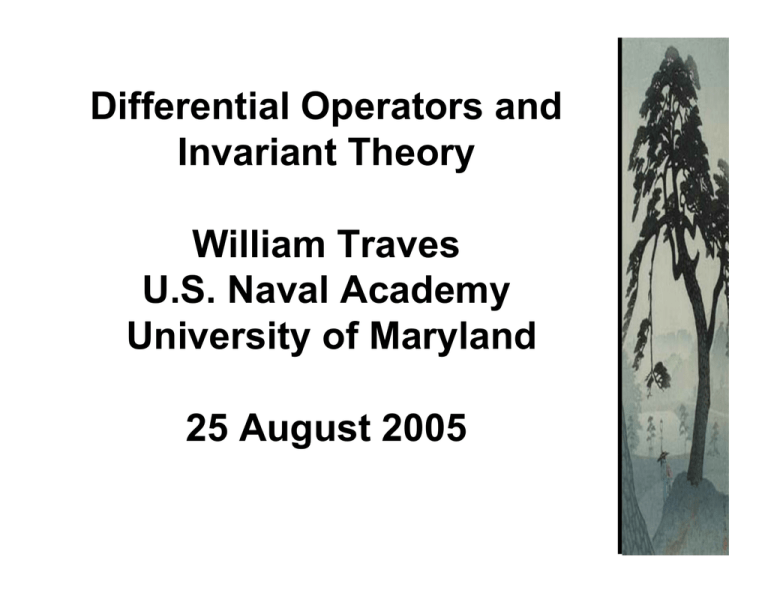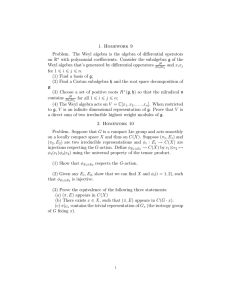Differential Operators and Invariant Theory William Traves U.S. Naval Academy
advertisement

Differential Operators and
Invariant Theory
William Traves
U.S. Naval Academy
University of Maryland
25 August 2005
Plan
• Invariant Theory
• Rings of invariants, RG
• Derksen’s algorithm
• Differential symmetries of RG
• Ideals in the Weyl algebra
• The symmetry algebra and D(RG)
• Computing D(RG)
Rings of Invariants
When a group G acts on X = Spec(R),
it is customary to consider the
categorical quotient X//G = Spec(RG).
The ring RG is the ring of invariants:
RG = { r ∈ R: g•r = r for all g ∈ G}.
Ex: If G = <σ: σ2 = id> acts on R=C[x,y]
via σ•x = -x and σ•y = -y then
RG = C[x2, xy,y2].
Example: binary forms
The geometry of (pairs of) points on P1
is controlled by the (deg 2) forms.
Let X = {ax2 + bxy + cy2} = Proj C[a,b,c]
G = SL2C acts on P1 and moves the roots
of a form, so G acts on X:
g•a = g1,12 a + 2g1,1g2,1 b + g2,12 c
g•b = g1,1g1,2a + (g1,1g2,2+g1,2g2,1)b + g2,1g2,2c
g•c = g1,22 a + 2g1,2g2,2 b + g2,22 c
RG = C[a,b,c]SL2C = C[b2-4ac]
Properties of RG
It is generally difficult to compute RG
explicitly (c.f. Takashi Wada’s talk).
Gordan and Hilbert showed that RG is
finitely generated when G is lin. reductive
and Nagata gave a counterexample when
G is not lin. reductive.
Computing invariants
Several methods:
(1) Gordan’s symbolic calculus (P. Olver)
(2) Cayley’s omega process
(3) Lie algebra methods (Sturmfels)
(4) Derksen’s algorithm
Harm Derksen
Gregor Kemper
Derksen’s Algorithm
(1) Hilbert ideal I = ideal of R gen by RG>0
(2) To find I, we first look at the map
Compute the ideal β by elimination and set
y’s to 0 to get gens for the Hilbert ideal.
(3) The gens of I may not be invariants but
we can average them over the group action
to get invariants that generate I and RG.
Example: binary forms
Plan
• Invariant Theory
• Rings of invariants, RG
• Derksen’s algorithm
• Differential symmetries of RG
• Ideals in the Weyl algebra
• The symmetry algebra and D(RG)
• Computing D(RG)
Differential symmetries
One way to study any ring of functions
is to understand the ring as the solutions
to a system of differential equations.
Cayley developed a
system of diff. eqs
that characterize the
invariants of forms
(the G=SL2C case).
Arthur Cayley
Passage to GL2C
The Lie algebra method works with
GL2C rather than SL2C. There is a close
connection between the invariants of
these two groups.
A function f is said to be an “invariant of
index γ” if g•f = (det g)γ f for all g ∈GL2C.
Theorem: For binary forms,
GL2C-invariants of index γ =
homog. SL2C-invariants of degree 2γ/d.
Example: degree 2 forms
Degree 2 form: F(x,y) = ax2 + bxy + cy2.
g•a = g1,12 a + 2g1,1g2,1 b + g2,12 c
g•b = g1,1g1,2a + (g1,1g2,2+g1,2g2,1)b + g2,1g2,2c
g•c = g1,22 a + 2g1,2g2,2 b + g2,22 c
Now if f(a,b,c) has index γ then
f(λ2a, λτb, τ2c) = (λτ)γf(a,b,c). This forces
every monomial m in f to have
2dega m + 1degb m + 0degc m = γ and
0dega m + 1degb m + 2degc m = γ.
Example continued
Cayley’s Differential System
ax2 + bxy + cy2
a2x2 + a1xy + a0y2
Cayley’s Differential System
ax2 + bxy + cy2
a2x2 + a1xy + a0y2
Ideals in the Weyl algebra
We can make Cayley’s system into an
algebraic object using the Weyl algebra.
Weyl algebra: W = C[x1,…,xn]<∂1,…, ∂n>
Systems of linear PDEs
left ideals in W
• f satisfies Δ1f = Δ2f = … = 0
f is
annihilated by the left ideal W(Δ1,Δ2,…)
Solutions to system of DEs correspond to
elements of HomW(W/J, C[x1,...,xn])
Cayley’s Differential System
Jd : characterizes invariants
Jd(γ) : invariants of order γ
Symmetry algebra
M. Saito and I used the symmetry algebra
to study systems of hypergeometric DEs.
A: matrix, β: complex vector
Δ∈S(W/JA)
HA(β)
Then f is a soln to HA(β)
Δ•f is a soln to HA(β’) for some β’.
Symmetry algebra
S(W/J) =
Theorem : S(W/J d
€
{Δ ∈ W : JΔ ⊆ J}
{Δ ∈ W :
)=
{Δ ∈ W :
J
Δ • R G ⊆ R G}
Δ • RG = 0 }
⊆ D(R G )
Equality holds when Jd = AnnW(RG).
Question: How can we compute S(W/Jd)?
This looks hard so we pass to the
study of D(RG).
Differential Operators
If R is a k-algebra then D(R) ⊂ EndkR.
In general D(R) is very difficult to compute
and may not be finitely generated.
One nice example: D(C[x1,..,xn]) = W.
G acts on C[x1,…,xn] via the matrix M and
this induces an action on the ∂i’s via the
matrix (M-1)T.
So it makes sense to ask for D(R)G = WG,
the ring of invariant differential operators.
D(R)G vs. D(RG)
Unfortunately, D(R)G is not equal to D(RG).
π: RG R induces π*: D(R)G D(RG) by
restriction
θ∈D(R)G
R
R
Reynolds
RG
RG
π*θ∈D(RG)
Theorem: if Jd=AnnWRG then
im(π*) ⊂ S(W/Jd) ⊂ D(RG)
Failure of surjectivity
We’ve got a map π*: D(R)G D(RG).
Have Im(π*) ⊂ S(D(R)/J) ⊂ D(RG).
Musson and Van den Bergh showed that the
map π* may not be surjective (G = torus).
Ian Musson
M. Van den Bergh
Surjective when it counts
Schwarz showed that the map π* is
surjective in many cases of interest. In fact,
he showed that the Levasseur-Stafford
Alternative holds for SL2C representations:
Either (1) RG is regular or
(2) the map π* is
graded surjective
In most cases RG is not regular
and so π* is (graded) surjective.
Then: im(π*) = S(W/Jd) = D(RG).
Gerry Schwarz
Graded Surjectivity
The Weyl algebra D(R)=W is filtered by
order (degree in the ∂’s). The associated
graded ring is just a polynomial ring in 2n
variables.
Saying that the map π*: D(R)G D(RG) is
graded surjective means that the induced
map [grD(R)G] grD(RG) is surjective.
So to produce generators of grD(RG)
(and hence D(RG)) it is enough to get
generators of grD(R)G.
Computing D(RG)
Since grD(R)G = [grD(R)]G is a poly. ring,
we can use Derksen’s algorithm to
compute [grD(R)]G. These generators
lift immediately to generators of D(RG).
Ex. D(C[a0,a1,a2]SL2C) =
C[a12-4a0a2, a0∂0+a1∂1+a2∂2, ∂12-∂0∂2]
Bad news: d>2 seems hard!
Ex. D(C[x,y]Z/2Z) =
C[x2,xy,y2,x∂x,x∂y,y∂x, y∂y, ∂x2, ∂x∂y, ∂y2]
Plan
• Invariant Theory
• Rings of invariants, RG
• Derksen’s algorithm
• Differential symmetries of RG
• Ideals in the Weyl algebra
• The symmetry algebra and D(RG)
• Computing D(RG)
